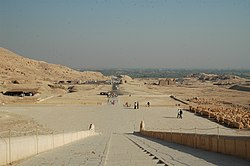| Theban tomb Bab el-Gasus | |
|---|---|
| Burial site of multiple priests | |
 The entrance to the tomb is on the left of this photo taken from the Mortuary Temple of Hatshepsut | |
| Coordinates | 25°44′16″N 32°36′31″E / 25.7379°N 32.6086°E |
| Location | Deir el-Bahari, Theban Necropolis |
| Discovered | 1891 |
Bab el-Gasus (Egyptian Arabic: باب الجسس, romanized: bāb el-gasus, lit. 'Gate of the Priests [Spies]'[1]), also known as the Priestly Cache and the Second Cache, was a cache of ancient 21st dynasty (c. 1070–945 BCE) Egyptian mummies found at Deir el-Bahari in 1891. It was excavated by French Egyptologists Eugène Grebaut and Georges Daressy, with Urbain Bouriant and Ahmed Kamal, on the direction of Mohamed Ahmed Abd al‑Rassul, who had also revealed the location of the Royal Cache in 1881. The tomb entrance was located on the flat area just outside the precinct wall in front of the Mortuary Temple of Hatshepsut. The find was significant for Egyptology, particularly in respect of religion, mummification, and coffin studies.[2] It is the largest intact tomb ever found in Egypt.[3] Today, the contents of the tomb are spread between 30 museums worldwide.[4]
In 1893, Khedive Abbas II of Egypt presented groups of artefacts from the tomb to 16 countries, as gifts celebrating the Khedive's accession to the throne.[5] As a result of this dispersion, the artefacts have received limited focus by scholars.[2]
It contained 254 richly decorated coffins (101 double sets) giving 153 coffin sets in total, as well as 110 shabti boxes, 77 Osirian wooden statuettes (mostly hollow and containing a papyrus), 8 wooden steles, 2 large wooden statues (Isis and Nephthys), 16 canopic reed baskets, 5 round baskets made of woven reed.[6] The coffins were made almost exclusively with wood from the native fig tree, the Ficus sycomorus.[7]
On the 125th anniversary of the find, the Centro de Estudos Clássicos e Humanísticos of the University of Coimbra launched the "Gate of the Priests" project, with the University of Leiden, the National Museum of Antiquities of Leiden, the Vatican Museums and UCLA, in order to reconstruct the original collection of Bab el-Gasus.
A new display of the Bab el-Gasus artefacts was opened at the Egyptian Museum in Cairo in 2021 following the moving of the Royal Cache.[8][3]
Although one of the Theban tombs, the tomb never received a serial number.[9]
- ^ Sousa, Rogério; Amenta, Alessia; Cooney, Kathlyn M., eds. (2021). Bab El Gasus in Context: Rediscovering the Tomb of the Priests of Amun (PDF). Rome: "L'Erma" di Bretschneider. ISBN 978-88-913-2071-1. Archived from the original (PDF) on 16 June 2021. Retrieved 29 April 2022. p. 17: "Daressy’s moniker ‘Tomb of the Priests’ likely finds its origins in the local traditions of Sheikh abd el Gurnah. Indeed, this phrase could be translated directly from the dialectal form of Arabic in use by Gurnawi workmen, resulting in the local designation of the tomb as ‘Bab el-Gasawsa’, which literally means ‘Gate of the Priests’, as Egyptians traditionally see pharaonic tombs as ‘gates’ into the netherworld. This Arabic phrase was probably wrongly interpreted by Herbert Winlock, who recorded it as ‘Bab el-Gasus’, which in fact means ‘Gate of the Spies’. It is perhaps for this reason that the expression was corrected to ‘Bab el-Kusus’, certainly by scholars familiar with the Cairene form of Arabic, and eventually adapting it to the typical Gurnawi pronunciation and spelling with a -g, instead of -k, resulting in the name ‘Bab el-Gusus’."
- ^ a b Review by Marissa Stevens, University of California, Los Angeles of Rogério Sousa, Burial Assemblages from Bab el-Gasus in the Geographical Society of Lisbon. Monumenta Aegyptiaca, 14. Turnhout: Brepols, 2017
- ^ a b "The 117th Anniversary of the Egyptian Museum". Archived from the original on 2021-05-11. Retrieved 2022-04-16.
- ^ The Most Famous Ancient Egyptian Site You Have Never Heard Of Archived 2021-04-21 at the Wayback Machine, Egypt Today, 10 Jul 2016: "Yet, in the thirty or so museums abroad where the coffins are to be found"
- ^ Maio, M. (2018). Proceedings of the 4th Biennial of Architectural and Urban Restoration. Host of the Itinerant Congress Hidden Cultural Heritage: Under Water, Under Ground and Within Buildings. CICOP Italia. p. 107. ISBN 978-88-909116-5-1. Retrieved 2022-04-16.
- ^ Daressy 1900, pp. 141–148.
- ^ Giachi, G.; Guidotti, M.C.; Lazzeri, S.; Macchioni, N.; Sozzi, L. (2021). "Wood identification of some coffins from the Necropolis of Thebes held in the collection of the Egyptian Museum in Florence". Journal of Cultural Heritage. 47. Elsevier BV: 34–42. doi:10.1016/j.culher.2020.09.007. ISSN 1296-2074. S2CID 228962795.
- ^ "الخبيئة بديل المومياوات الملكية بمتحف التحرير.. تعرف على محتوياتها". 14 June 2021. Archived from the original on 2021-10-16. Retrieved 2022-04-16.
- ^ Sousa, Amenta & Cooney 2021, p. 17. "The tomb itself never received a serial number."
